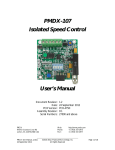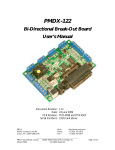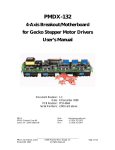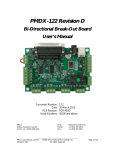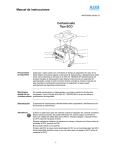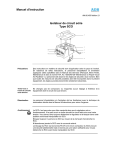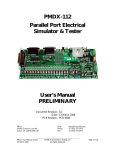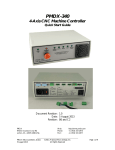Download PMDX-106 USer`s Manual, Revision 0.3
Transcript
PMDX-106 Spindle Controller User’s Manual Document Revision: Date: PCB Revision: Firmware Revision: PMDX 9704-D Gunston Cove Rd Lorton, VA 22079-2366 USA PMDX-106_Manual_03.doc 4 August 2008 0.3 4 August 2008 PCB-455C thru PCB-455E 1.2 Web: Phone: FAX: http://www.pmdx.com +1 (703) 372-2975 +1 (703) 372-2977 ©2007-2008, Practical Micro Design, Inc. All Rights Reserved Page 1 of 29 PMDX-106 User’s Manual Document Revision: 0.3 PCB Revision: PCB-455C thru PCB-455E Firmware Revision: 1.2 Table of Contents 1.0 Overview.................................................................................................................................... 3 1.1 Ordering Information (part numbers) ........................................................................................................... 3 1.2 Definitions ............................................................................................................................................................. 3 1.3 Important Safety Information ........................................................................................................................... 3 1.4 Warranty Summary............................................................................................................................................. 4 1.5 Features.................................................................................................................................................................. 4 1.6 Updates to this Manual ...................................................................................................................................... 4 2.0 Quick Start Guide..................................................................................................................... 5 2.1 Example Connections to PMDX-132............................................................................................................. 5 2.2 Example Connections to PMDX-122............................................................................................................. 6 2.3 Example Connections Using Universal Interface......................................................................................... 9 2.4 Connections to Remote Operator Panel....................................................................................................10 2.5 VSD Speed Control Interface.........................................................................................................................12 2.6 VSD Run/Direction Interface..........................................................................................................................14 2.7 Configuring DIP Switches ................................................................................................................................15 2.8 VSD Speed Calibration.....................................................................................................................................15 2.9 Configuring PC Control Signals .....................................................................................................................16 3.0 Technical Reference ............................................................................................................... 17 3.1 Functional Overview.........................................................................................................................................17 3.2 PWM Input..........................................................................................................................................................17 3.3 Power Supply Isolation.....................................................................................................................................18 3.4 “Manual” and “Auto” Modes ..........................................................................................................................18 4.0 DIP Switches ........................................................................................................................... 19 5.0 Jumpers .................................................................................................................................... 20 6.0 LED Indicators ........................................................................................................................ 21 7.0 Connectors .............................................................................................................................. 22 7.1 External Speed Control Pot Connector (J1)..............................................................................................22 7.2 Spindle Signal Connector (J2).........................................................................................................................22 7.3 External Control Input Connectors (J3 and J9).........................................................................................23 7.4 External Power Supply Connector (J4) .......................................................................................................23 7.5 PMDX Interface Connector (J5)....................................................................................................................24 7.6 Forward/Run Relay Connector (J6)..............................................................................................................24 7.7 Aux. Forward/Run Relay Connector (J7)....................................................................................................24 7.8 Reverse/Direction Relay Connector (J8) ....................................................................................................25 7.9 Manual Forward/Reverse Connector (J10).................................................................................................25 7.10 Forward/Reverse Remote LED Connector (J11)......................................................................................25 7.11 Remote Operator Panel Connector (J12) ..................................................................................................26 8.0 Mechanical Specifications...................................................................................................... 27 9.0 Electrical and Environmental Specifications ...................................................................... 28 Appendix A – Warranty.................................................................................................................... 29 PMDX-106_Manual_03.doc 4 August 2008 ©2007-2008, Practical Micro Design, Inc. All Rights Reserved Page 2 of 29 PMDX-106 User’s Manual Document Revision: 0.3 1.0 PCB Revision: PCB-455C thru PCB-455E Firmware Revision: 1.2 Overview This document describes the configuration and operation of the PMDX-106 Spindle Controller. This document pertains to the following versions of the PMDX-106: Circuit Board Revision: Assembly Revision: Firmware Revision: 1.1 PCB-455C thru PCB-455E (marked on the bottom of the board) Blank 1.2 Ordering Information (part numbers) The PMDX-106 can be built with or without components that allow the board to be mounted to an operator’s panel, as designated by the full part numbers: Part Number PMDX-106 PMDX-106-OP Features No operator panel components Operator panel components (manual forward/reverse switch, speed control pot and status LEDs) 1.2 Definitions PWM VFD VSD Pulse width modulation – a digital signal that represents an analog voltage as a pulse stream Variable Frequency Drive, used with 3-phase AC motors Variable Speed Drive, either a DC motor speed control or a VFD 1.3 Important Safety Information The PMDX-106 is intended for integration by the purchaser into industrial control systems. It is solely the purchaser's responsibility to assure that the system is configured in a manner consistent with applicable safety requirements. Practical Micro Design, Inc. does not control how this board is integrated into the purchaser's system and cannot be responsible for guaranteeing the safety of your system. The PMDX-106 is not guaranteed to be fail-safe. The system into which the PMDX-106 is installed should provide fail-safe protection and emergency stop capability. WARNING - SHOCK HAZARD: The VSD’s analog “ground” reference is NOT necessarily at earth ground potential. Likewise, the control signals for forward, reverse, etc. may not be referenced to ground. Any of these may be at “mains” potential, which may be several hundred volts above ground. These potentially dangerous voltages appear on PMDX-106 connectors J1, J2, J6, J7 and J8 and on portions of the PMDX-106 circuit board. All wiring from the PMDX-106 to the VSD should be treated as HOT and suitably protected Care must be taken that user cannot come in contact with these voltages. An enclosure that allows for adequate ventilation, but prevents intrusion by operator’s hands and foreign objects, especially conductive byproducts of machining operations, should be utilized with this board. Interlock switches on power circuits should remove power when the enclosure is opened. Always disconnect mains power from BOTH the CNC control system and the VSD before working on the wiring connected to either. Automated machine tools, into which the PMDX-106 may be integrated, can cause injury. Precautions should be taken to assure that operators are trained in their proper operation and safety procedures, and that they are protected from moving parts that may be under remote control and may move unexpectedly. This product may not be used in life support or other critical safety applications. PMDX-106_Manual_03.doc 4 August 2008 ©2007-2008, Practical Micro Design, Inc. All Rights Reserved Page 3 of 29 PMDX-106 User’s Manual PCB Revision: PCB-455C thru PCB-455E Firmware Revision: 1.2 Document Revision: 0.3 1.4 Warranty Summary The PMDX-106 is warranted against failure due to defective parts or workmanship for 90 days from the date of sale. Refer to Appendix A for complete warranty details. If you have an item requiring service, please see the support page on the PMDX web site (http://www.pmdx.com) for return instructions. The purchaser must pay shipping to return the unit to PMDX. We will ship the repaired unit back to you via ground transportation at our expense. Repairs are normally completed within 10 business days. See Appendix A for our complete warranty details. 1.5 Features The PMDX-106 has the following features: • Available with or without board mounted pot, switches, and indicators for use as a manual operator panel • Fully isolated interface can be used with nonisolating VSD's Works with 0-5 volt, 0-10 volt, or potentiometer interfaces to a VSD • Operates from a single power supply or receives power from PMDX-132 • Provides two dry contact relays for Forward and Reverse -OR- Run and Direction • Provides switchable filter to limit speed ramp rate • Provides switching from automatic to manual operation • Provides safety interlock for "charge pump" monitor and missing PWM • Provides test button, min-speed pot, and max-speed pot for calibration • Controls spindle speed using PWM from control software • Presence of valid PWM signal is used to turn the spindle on, no dedicated RUN/STOP signal is required. • NOTE: 1.6 The PMDX-106 is not suitable for use with “universal” motor controllers such as wood routers. Updates to this Manual Check the PMDX web site for revisions or updates to this manual (http://www.pmdx.com). The latest revision of this manual is available on the PMDX-106 page (follow the links from the main page). PMDX-106_Manual_03.doc 4 August 2008 ©2007-2008, Practical Micro Design, Inc. All Rights Reserved Page 4 of 29 PMDX-106 User’s Manual Document Revision: 0.3 2.0 PCB Revision: PCB-455C thru PCB-455E Firmware Revision: 1.2 Quick Start Guide The following sections show the steps necessary to install, configure and use the PMDX-106. In general, the steps are: 1) Connect the PMDX-106 to the source of the PWM and direction signals (see sections 2.1, 2.2 and 2.3) 2) Optionally, connect the PMDX-106 to remote operator panel (manual) controls and indicators (see section 2.4) WARNING – SHOCK HAZARD: Please see the warning in section 2.4 regarding potentially hazardous voltages. 3) Connect the PMDX-106 to the VSD’s “speed control” interface and configure the PMDX-106 jumpers (see section 2.5) WARNING – SHOCK HAZARD: Please see the warning in section 2.5 regarding potentially hazardous voltages. 4) Connect the PMDX-106 to the VSD’s Run/Direction or Forward/Reverse controls (see section 2.6) 5) Set the PMDX-106 DIP switches (see section 4.0) 6) Calibrate the PMDX-106 speed control output voltage (see section 2.8) 7) Configure the PC (or other controller) to generate the proper signals. 2.1 Example Connections to PMDX-132 The PMDX-106 is designed to connect directly to the PMDX-132 (or PMDX-131) Breakout/Motherboard via a 10-pin ribbon cable (available on our web site). All power supply and control signals are brought in to the PMDX-106 via this 10-pin ribbon cable. No external power supply is required. When connected to a PMDX-132, the following PC parallel port signals are used to control the spindle interface: PC parallel port pin 14 is the Spindle Direction signal. PC parallel port pin 16 is the PWM signal PC parallel port pin 17 is the Charge Pump signal (optional, see below) If the PMDX-106 DIP switch #4 (“Ignore CPOK”) is set to “off”, then the PMDX-132 must be configured to enable the “Charge Pump” feature, and must have its “Pin 17” output configured as the “CP-OK” (Charge Pump OK) signal. To do so, set the following PMDX-132 jumpers (also shown in Figure 1): PMDX-132 jumper JP1 Short pins 2 to 3 (enables the charge pump) PMDX-132 jumper JP 2 Short pins 2 to 3 (sets the “Pin 17” output to the “CP-OK” signal) PMDX-106_Manual_03.doc 4 August 2008 ©2007-2008, Practical Micro Design, Inc. All Rights Reserved Page 5 of 29 PMDX-106 User’s Manual PCB Revision: PCB-455C thru PCB-455E Firmware Revision: 1.2 Document Revision: 0.3 If DIP Switch #4 is set to “on”, then the PMDX-106 ignores the “CP-OK” signal and the PMDX-132 jumpers can be configured in any manner that fits the rest of your system. See section 4.0 for more information on the PMDX-106 DIP switch settings. See Figure 1 for an example of the connections to a PMDX-132 and for the PMDX-132 jumper settings. Refer to the PMDX-132 User’s Manual for more information on the “charge pump” feature and on configuring its jumpers. Optional Operator Panel Components (only installed on PMDX-106-OP models) PMDX-132 VSD VSD CP-OK output enable not EStop Local JP1 J23 10-pin Ribbon Cable CP-OK pin 17 mode normal JP2 Figure 1 – Example Configuration with PMDX-132 2.2 Example Connections to PMDX-122 The PMDX-106 can also connect to a PMDX-122 Bi-directional Breakout Board via the screw terminals and discrete wires. For this configuration you will need an external power supply to power both the PMDX-122 and the PMDX-106. NOTE: The PMDX-122 cannot be powered from its USB connector when connected to a PMDX-106. You must use an external regulated or unregulated power supply for the PMDX-122. The same power supply can be used for both the PMDX-122 and the PMDX-106. When connected to a PMDX-122, the following PC parallel port signals are recommended to control the spindle interface (note that this is the same as the PMDX-132 configuration): PMDX-106_Manual_03.doc 4 August 2008 ©2007-2008, Practical Micro Design, Inc. All Rights Reserved Page 6 of 29 PMDX-106 User’s Manual Document Revision: 0.3 PCB Revision: PCB-455C thru PCB-455E Firmware Revision: 1.2 PC parallel port pin 14 is the Spindle Direction signal. PC parallel port pin 16 is the PWM signal PC parallel port pin 17 is the Charge Pump signal (optional, see below) If the PMDX-106 DIP switch #4 (“Ignore CPOK”) is set to “off”, then the PMDX-122 must be configured to enable the “Charge Pump” feature, and must have its “Pin 17” output configured as the “CP-OK” (Charge Pump OK) signal. To do so, set the following PMDX-122 jumpers (also shown in Figure 2): PMDX-122 jumper JP2 PMDX-122 jumper JP3 PMDX-122 jumper JP4 Short pins 2 (“pin 2-9 enable”) to 3 (“OK”) Short pins 2 (“Outputs Enabled”) to 3 (“CP-OK & not EStop/Fault”) (enables the “charge pump”) Short pins 2 (“pin17out”) to 3 (“OK”) (sets the “Pin 17” output to the “CP-OK” signal) If DIP Switch #4 is set to “on”, then the PMDX-106 ignores the “CP-OK” signal and the PMDX-122 jumpers can be configured in any manner that fits the rest of your system. See section 4.0 for more information on the PMDX-106 DIP switch settings. All other jumpers on the PMDX-122 should be set according to your system configuration. See Figure 2 for an example of the connections to a PMDX-122 and for the PMDX-122 jumper settings. Refer to the PMDX-122 User’s Manual for more information on the “charge pump” feature and on configuring its jumpers. Power Supply Options The combination of PMDX-122 and PMDX-106 can share a common power supply. This supply can be a 9 VAC or 7 to +12 VDC regulated or unregulated power pack, as shown in Figure 2. Or, the boards can be powered from a regulated +5V DC power supply. When powered by a +5V DC supply, ignore the power supply connections shown in Figure 2 and connect the power supply as follows: +5V PMDX-122 connector J8 pin 1 (labeled “+5V Aux Out”) PMDX-106 connector J4 pin 2 (labeled “+5V”) GND PMDX-122 connector J8 pin 6 (labeled “GND”) PMDX-106 connector J4 pin 1 (labeled “GND”) Do not connect any other power supply to the PMDX-122! PMDX-106_Manual_03.doc 4 August 2008 ©2007-2008, Practical Micro Design, Inc. All Rights Reserved Page 7 of 29 PMDX-106 User’s Manual PCB Revision: PCB-455C thru PCB-455E Firmware Revision: 1.2 Document Revision: 0.3 Optional Operator Panel Components (only installed on PMDX-106-OP models) normal J10 JP6 J11 J12 E-Stop Mode signal only J6 + PWR Alt In fault E-Stop J9 GND pin17 normal pin17out "OK" J5+5V AUX OUT GND JP4 JP5 always pin 2-9 enable OK out JP2 DIR ** ** See text for using a +5VDC regulated supply pin16 pin14 See text for description of jumper settings pin11 +5V AUX OUT J8 The Pin 17 to "CPOK In" wire is optional. See text. pin12 JP1 pin13 pin15 GND J1 JP3 +5V pin 2-9 COM GND pin2 pin3 COM not EStop/fault Outputs Enabled CP-OK & not EStop/fault pin4 pin5 COM J2 N/C RLY COM N/O pin6 pin7 COM J3 9V AC or 7-12V DC unregulated Power - Supply** pin8 pin9 COM J7 J4 Figure 2 – Example Configuration with PMDX-122 PMDX-106_Manual_03.doc 4 August 2008 ©2007-2008, Practical Micro Design, Inc. All Rights Reserved Page 8 of 29 PMDX-106 User’s Manual Document Revision: 0.3 2.3 PCB Revision: PCB-455C thru PCB-455E Firmware Revision: 1.2 Example Connections Using Universal Interface The “universal” interface uses the screw terminals to connect the power supply and control signals into the PMDX-106. The allows the PMDX-106 to be used with any breakout board or other control system that can output PWM and direction signals. NOTE: If your breakout board or control system does not output a signal that can function as a “Charge Pump OK” signal, then leave the “CP-OK” input disconnected and set the PMDX-106 DIP switch number 4 (“Ignore CPOK”) to “On”. With the universal interface, the PMDX-106 requires an external power supply. This can be either a regulated +5V DC, or an unregulated “wall wart” style power supply. See Section 9.0, Electrical and Environmental Specifications, for the requirements of the external power supply. Optional Operator Panel Components (only installed on PMDX-106-OP models) Regulated +5VDC supply VSD VSD Local *OR* 9V AC or 7-12V DC unregulated Ground reference Direction Input Ground reference Charge Pump OK (optional) PWM Input Figure 3 – Example Configuration using Universal Interface NOTE: The sources for the DIR, CPOK and PWM signals must share the same ground reference. PMDX-106_Manual_03.doc 4 August 2008 ©2007-2008, Practical Micro Design, Inc. All Rights Reserved Page 9 of 29 PMDX-106 User’s Manual Document Revision: 0.3 2.4 PCB Revision: PCB-455C thru PCB-455E Firmware Revision: 1.2 Connections to Remote Operator Panel The PMDX-106-OP provides the switches, potentiometer and LEDs necessary for manual operation and can be mounted directly to the operator panel. The PMDX-106 does not have these components installed. Both versions of the board, however, provide screw terminal connectors for wiring off-board operator panel components. This allows the PMDX-106 to be mounted away from the operator panel. The remote operator panel consists of the following: • Manual Forward and Reverse switch (usually a single-pole double-throw center-off switch) • Optional “Manual Mode” switch (single-pole single-throw) • Speed control potentiometer (typically a 5K Ohm pot) • Three LEDs to indicate when the PMDX-106 is in “Auto” mode (i.e. controlled by the PWM input), VSD moving forward, or VSD moving backwards. Note: When using the PMDX-106-OP with an additional speed control potentiometer connected to J1, you MUST set DIP switch #5 (labeled “Onboard Pot”) to “off”. Otherwise the on-board potentiometer will be connected in parallel to the remote potentiometer and will interfere with the manual speed control. See Figure 4 for an example of connections to a remote operator panel. WARNING – SHOCK HAZARD: When jumper JP2 is set to “VSD”, the voltages present on the remote potentiometer connector (J1) may not be referenced to ground. They may be at “mains” potential, which may be several hundred volts above ground. The wiring from the PMDX-106 to the remote panel potentiometer should be treated as HOT and suitably protected DO NOT connect any terminal on connector J1 to any other connector on the PMDX-106. Specially not to any ground (“GND”) signal. At best, doing so will defeat the isolation provided by the PMDX-106. At worst, it will destroy the electronics in your system. DO NOT connect any terminal on J1 to the low-voltage power supply ground. PMDX-106_Manual_03.doc 4 August 2008 ©2007-2008, Practical Micro Design, Inc. All Rights Reserved Page 10 of 29 PMDX-106 User’s Manual Document Revision: 0.3 PCB Revision: PCB-455C thru PCB-455E Firmware Revision: 1.2 Fwd LED VSD VSD Fwd Local Stop Rev DPDT Center Off Rev LED See Warning !! CCW Auto (when switch is off) Manual (when switch is on) Auto LED CW Manual Speed Control SPST Figure 4 – Example Remote Operator Panel Connections PMDX-106_Manual_03.doc 4 August 2008 ©2007-2008, Practical Micro Design, Inc. All Rights Reserved Page 11 of 29 PMDX-106 User’s Manual Document Revision: 0.3 2.5 PCB Revision: PCB-455C thru PCB-455E Firmware Revision: 1.2 VSD Speed Control Interface The VSD speed control interface on the PMDX-106 generates an analog voltage proportional to the desired VSD speed. This voltage can be the result of an incoming PWM signal, or from a potentiometer connected to the PMDX-106. The PMDX-106 supports three different analog speed control interfaces: 0 to +5V The VSD expects an analog voltage between 0 and +5V, where +5V is full speed. In this case, the PMDX-106 provides the +5V reference for its analog output circuit. See Figure 5 for an example of the jumper settings and VSD connections for this configuration. 0 to +10V The VSD expects an analog voltage between 0 and +10V, where +10V is full speed. In this case, the PMDX-106 provides the +10V reference for its analog output circuit. See Figure 6 for an example of the jumper settings and VSD connections for this configuration. Potentiometer (ratiometric) The VSD expects to be connected to an external potentiometer. In this case, the VSD provides the analog reference voltage to the PMDX-106’s analog output circuit. See Figure 7 for an example of the jumper settings and VSD connections for this configuration. The VSD must not apply greater than +15 volts to the PMDX-106 reference input at J2 pin 3 (referenced to J2 pin 1). WARNING – SHOCK HAZARD: The VSD’s analog “ground” reference is NOT necessarily at earth ground potential. Likewise, the control signals for forward, reverse, etc. may not be referenced to ground. Any of these may be at “mains” potential, which may be several hundred volts above ground. These potentially dangerous voltages appear on PMDX-106 connectors J1, J2, J6, J7 and J8 and on portions of the PMDX-106 circuit board. All wiring from the PMDX-106 to the VSD should be treated as HOT and suitably protected The PMDX-106 contains isolation circuitry between the VSD interface and the lowvoltage control inputs. DO NOT connect any terminal on connectors J1, J2, J6, J7 or J8 to any other connector on the PMDX-106. Specially not to any ground (“GND”) signal. At best, doing so will defeat the isolation provided by the PMDX-106. At worst, it will destroy the electronics in your system. DO NOT connect any terminal on J1, J2, J6, J7 or J8 to the low-voltage power supply ground. PMDX-106_Manual_03.doc 4 August 2008 ©2007-2008, Practical Micro Design, Inc. All Rights Reserved Page 12 of 29 PMDX-106 User’s Manual J1 Speed Pot com 10V JP2 5V VSD Ref-to-Pot Local PCB Revision: PCB-455C thru PCB-455E Firmware Revision: 1.2 Low Set High Low Wiper High VSD J2 Speed Out JP1 Document Revision: 0.3 VSD 0 - 5VDC Ground PMDX-106 J1 Speed Pot com 10V JP2 5V VSD Ref-to-Pot Local Low Set High Low Wiper High VSD J2 Speed Out JP1 Figure 5 – Example 0V to 5V VSD Connections & Jumper Settings VSD 0 - 10VDC Ground PMDX-106 Figure 6 – Example 0V to 10V VSD Connections & Jumper Settings PMDX-106_Manual_03.doc 4 August 2008 ©2007-2008, Practical Micro Design, Inc. All Rights Reserved Page 13 of 29 PMDX-106 User’s Manual J1 Speed Pot com 10V JP2 5V VSD Ref-to-Pot Local PCB Revision: PCB-455C thru PCB-455E Firmware Revision: 1.2 Low Set High Low Wiper High VSD J2 Speed Out JP1 Document Revision: 0.3 VSD Reference Wiper Ground PMDX-106 Figure 7 – Example Ratiometric VSD Connections & Jumper Settings 2.6 VSD Run/Direction Interface The PMDX-106 provides three sets of relay contacts to control the running and direction of the VSD. Each set of relay contacts are provided as a “common” terminal, an “normally open” (n/o) terminal and a “normally closed” (n/c) terminal. The relay contacts are available on the following connectors: Connector J6 Label FWD (run) J7 AUX (run) J8 REV (dir) Description DIP Switch #2 determines the meaning of the signals on this connector, either “Forward/Stop” or “Run/Stop”. See Table 2 for more information. This set of relay contacts provides an electrically isolated copy of the “FWD (run)” relay contacts. These switch at the same time as the “FWD (run)” relay contacts. See Table 2 for more information. DIP Switch #2 determines the meaning of the signals on this connector, either “Forward/Stop” or “Run/Stop”. See Table 2 for more information. Table 1 - Summary of PMDX-106 Connectors for VSD Run/Direction Interface PMDX-106_Manual_03.doc 4 August 2008 ©2007-2008, Practical Micro Design, Inc. All Rights Reserved Page 14 of 29 PMDX-106 User’s Manual Document Revision: 0.3 PCB Revision: PCB-455C thru PCB-455E Firmware Revision: 1.2 WARNING – SHOCK HAZARD: The VSD’s analog “ground” reference is NOT necessarily at earth ground potential. It may be at “mains” potential, or it may be several hundred volts. These potentially dangerous voltages appear on PMDX-106 connectors J2, J6, J7 and J8 and on portions of the PMDX-106 circuit board. The PMDX-106 contains isolation circuitry between the VSD interface and the lowvoltage control inputs. DO NOT connect any terminal on connectors J2, J6, J7 or J8 to any other connector on the PMDX-106. Specially not to any ground (“GND”) signal. At best, doing so will defeat the isolation provided by the PMDX-106. At worst, it will destroy the electronics in your system. DO NOT connect any terminal on J2, J6, J7 or J8 to the low-voltage power supply ground. Connector J6 Contacts n/c to com n/o to com DIP Switch #2 “off” (Fwd/Rev mode) VSD halted VSD running forward J7 n/c to com n/o to com VSD halted VSD running forward J8 n/c to com n/o to com VSD halted VSD running reverse DIP Switch #2 “on” (Run/Dir mode) VSD halted VSD running (direction determined by J8) VSD halted VSD running (direction determined by J8) VSD direction = forward VSD direction = reverse Table 2 – Functionality of PMDX-106 VSD Run/Direction Signals See section 7.0 for a more detailed description of the signals on each of these connectors. Also, see section 4.0 for a more information on setting the DIP switches. 2.7 Configuring DIP Switches Set the DIP switches according to section 4.0. 2.8 VSD Speed Calibration The PMDX-106 contains built-in functionality to calibrate its analog speed control voltage that is output to the VSD. The PMDX-106 has two trim pots that are used to set the maximum and minimum VSD speed. Trim pot R3 (labeled “MAX”) sets the maximum spindle speed, and R2 (labeled “MIN”) sets the minimum spindle speed. Use the following steps to calibrate the output voltage: 1) Connect the PMDX-106 as described in the previous sections. 2) Set both trim pots to their full counter-clockwise positions 3) Make sure that everything is clear of the spindle!!! 4) Apply power to the PMDX-106 and the VSD 5) Press & release the push button on the PMDX-106 one time. The PMDX-106 will output its maximum PWM voltage and will command the VSD to run the spindle in the forward direction. PMDX-106_Manual_03.doc 4 August 2008 ©2007-2008, Practical Micro Design, Inc. All Rights Reserved Page 15 of 29 PMDX-106 User’s Manual Document Revision: 0.3 PCB Revision: PCB-455C thru PCB-455E Firmware Revision: 1.2 6) Adjust the “MAX” trim pot (R3) until the spindle motor just reaches its maximum speed. Do not increase the setting of R3 above the point at which the motor reaches maximum speed as this will distort the speed control curve. 7) Press & release the push button on the PMDX-106 again. The PMDX-106 will set the speed control output to 30% of full speed with the VSD commanded in the forward direction. The 30% speed is intended to be above the low speed cutoff threshold imposed by some VSD units. If your VSD does not run at this test speed, please contact us for further advice. 8) Adjust the "MIN" trim pot (R2) until the spindle motor runs at 30% of full speed. If you know that your VSD's analog input linearly maps speed from zero volts to full scale (likely the case on VFD's with true analog inputs, unlikely on VSD's with ratiometric pot inputs and on DC motor speed controls), then you can simply set R2 to its maximum counter clockwise position. NOTE: Some VSD controllers enforce a minimum motor speed that may be above the PWM voltage that the PMDX-106 can output during the ‘MIN” calibration step, even with the “MIN” trim pot set fully clockwise. If this is the case, leave the “MIN” trim pot set fully clockwise. You will then have to experiment with the PWM settings in your PC software to see what duty cycle results in the slowest possible spindle motor speed. See section 3.2 for more information. 9) Press & release the push button on the PMDX-106 one more time to exit the calibration mode and return to normal operation. 10) Repeat steps (5) through (9) until the settings on both trim pots no longer change. There should be little or no interaction between the MIN and MAX trim pot settings. 11) The speed control provided by the PMDX-106 is open loop. There is no compensation by the PMDX-106 for motor loading or other factors because there is no speed feedback on which to base a compensation. Normal expectations should be for control within +/- 5% of target speed under no load conditions. Speeds below 30% of full speed will likely suffer greatly under load. Speeds below 10% of full speed may track speed commands poorly. 2.9 Configuring PC Control Signals If you are using a PC to generate the spindle control signals and interfacing to the PMDX-106 through either a PMDX-132 or PMDX-122, then configure your software to output the following signals on the given parallel port pins: Signal Direction PWM Charge Pump PC Parallel Port Pin** 14 16 17 Description Spindle direction. 0 = Forward 1 = Reverse PWM (pulse width modulation). See section 3.2 for details of this signal. Charge Pump signal. This signal should be a rough approximation of a square wave. The PMDX-132 and PMDX-122 can be configured to use this signal to enable their outputs and in turn send a logic “high” to the PMDX-106 “CPOK” input. If your software does not support the charge pump function then you must set the “Ignore CPOK” DIP Switch to “on” (see section 4.0) Table 3 – PC Parallel Port Signals for PMDX-106 ** the parallel port pin numbers are based on the standard PC 25-pin “D” parallel port connector. If you are using something other than a PC to generate the spindle control signals, or are using a breakout board other than a PMDX breakout board, then configure your controller and breakout board according to their directions. PMDX-106_Manual_03.doc 4 August 2008 ©2007-2008, Practical Micro Design, Inc. All Rights Reserved Page 16 of 29 PMDX-106 User’s Manual Document Revision: 0.3 3.0 Technical Reference 3.1 Functional Overview PCB Revision: PCB-455C thru PCB-455E Firmware Revision: 1.2 This section will be filled in later. 3.2 PWM Input The PWM signal coming in to the PMDX-106 is idle at a logic “low” and active at a logic “high”. The duty cycle is measured as: (active duration) / (idle duration + active duration) The PWM frequency must be between 5 Hz and 1,000 Hz to be considered valid. The PWM duty cycle should be between 5% to 99.9%. The PMDX-106 has a delay when detecting a valid incoming PWM. This delay is noticeable only at slower PWM frequencies (typically 5 to 10 Hz). The PMDX-106 takes 2 PWM periods to measure the PWM duty cycle. It then requires 3 successive PWM measurements with valid frequencies to enable the output. The PMDX-106 considers absence of a PWM signal (i.e. 0% or 100% duty cycle) to be a “stop” command. When detecting a loss of PWM, there is a delay of approximately one-third of a second from the actual loss of PWM signal until the PMDX-106 commands the VSD to stop. The PMDX-106 is an “open loop” speed control interface. This type of interface has no way of knowing about or correcting for speed deviations. Most applications will achieve 5% to 10% accuracy, but no guarantee of accuracy can be given because of the number of factors involved. The PMDX-106 is designed to provide speed commands over a range of 5% to 100% of full rated speed. Settings below 5% may have significant error. Many VSDs will enforce a minimum speed greater than 5% (as much as 30%) to cool and protect the motor. In this case the motor will not start until the PWM reaches a suitable value. The PMDX-106 uses the absence of a valid PWM signal to stop the spindle motor. A valid PWM signal must always be pulsing on and off. A true 0% or 100% duty cycle signal does not pulse and will therefore turn off the spindle motor. Most control software, including MACH, will provide the proper signal formatting. WARNING: Mach3 Spindle Linearization Table Based on versions of Mach3 available to us at the time this manual was updated (Lockdown version R2.63 and Development version R3.041) PMDX recommends not using the spindle speed calibration function in Mach. Many systems do not stabilize fast enough and result in faulty data in the linearization table. Instead, PMDX recommends using the adjustment pots on the PMDX-106 for speed compensation (see section 2.8, VSD Speed Calibration, for more information. NOTE: If you have ever run the auto calibration, you will need to remove the existing linearization table. The table isstored in a file named “Linearity.dat” located in the “Mach3/macros/XXXX” directory, where “Mach3” is the directory into which you installed the Mach software (usually C:\Mach3), and “XXXX” is the name of the configuration. For example, if you installed Mach in the default directory and are using the Mach3Mill configuration, the file would be: C:\Mach3\macros\Mach3Mill\Linearity.dat You can either delete this file, or rename it to something like “Linearity_Old.dat”. PMDX-106_Manual_03.doc 4 August 2008 ©2007-2008, Practical Micro Design, Inc. All Rights Reserved Page 17 of 29 PMDX-106 User’s Manual Document Revision: 0.3 3.3 PCB Revision: PCB-455C thru PCB-455E Firmware Revision: 1.2 Power Supply Isolation The VSD interface is isolated from the low-voltage (computer) interface and power supply. Do not connect the VSD’s interface to the computer interface or power supply by any method other than connectors J1, J2, J6, J7 and J8 on the PMDX-106. Doing so will defeat the isolation. 3.4 “Manual” and “Auto” Modes “Manual” Mode VSD is controlled via direction switches and the manual speed control pot. When in manual mode, the PWM, Direction and CP_OK inputs on connectors J3, J9 and J5 are ignored. Manual mode is entered when any one of the following conditions exist: • On the PMDX-106-OP, the Fwd/Rev switch is toggled off of the center position (i.e. manually commanding the VSD to move in the forward or reverse direction) • The “FWD IN” terminal on J10 is grounded (manually commanding the VSD to move in the forward direction) • The “REV IN” terminal on J10 is grounded (manually commanding the VSD to move in the reverse direction) • The “Manual Switch” terminal on J12 is grounded. This puts the PMDX-106 into manual mode but does not command the VSD to move (the “FWD IN” and “REV IN” terminals, or the Fed/Rev switch on the PMDX-106-OP control the spindle movement). Using this input is a way to unconditionally prevent the PC (or other automated controller) from moving the spindle. “Auto” Mode VSD controlled from PC or other controller connected to the PMDX-106. Two different cases here: (1) PWM input is a PWM signal (DIP switch #3 is “off”) and the VSD speed is controlled via the PWM signal. The “Auto” LED is on for this case. (2) PWM input is a “on/off” signal (DIP switch #3 in “on – Ignore PWM) and VSD speed is controlled via the manual speed control pot. The “Auto” LED is off for this case (see section 6.0 for more information on the “Auto” LED). PMDX-106_Manual_03.doc 4 August 2008 ©2007-2008, Practical Micro Design, Inc. All Rights Reserved Page 18 of 29 PMDX-106 User’s Manual Document Revision: 0.3 4.0 PCB Revision: PCB-455C thru PCB-455E Firmware Revision: 1.2 DIP Switches The PMDX-106 contains 6 DIP switches that determine various aspects of its behavior. The DIP switches are numbered “1” through “6”. These numbers also appear on the DIP switch. The functional labels shown in the table below also appear on the circuit board’s silkscreen, next to the DIP switch. In the descriptions that follow, the switch positions are described as “on” or “off”. The “on” position is with the switch positioned towards the silk screen labels. The “off” position is with the switch positioned away from the silkscreen labels. The DIP switch also has an arrow pointing to the “ON” position. Swt 1 Label Option Set 2 F/R Mode State Off On Off On 3 Ignore PWM Off On 4 5 Ignore CPOK Off Onboard POT On Off On 6 Filter Option Off On Description Not used Not used Forward/Reverse Mode - relay outputs on connectors J6 and J7 are the “Run Forward” signal. Relay outputs on J8 are the “Run Reverse” signal. See section 2.6 for more information. Run/Direction Mode - relay outputs on connectors J6 and J7 are the “Run/Stop” signal. Relay outputs on J8 are the “Direction” signal. See section 2.6 for more information. PWM input drives the VSD speed via J2. If the PWM is valid (repetition rate between 5 Hz and 1000 Hz) then: • the relays are set to allow the VSD to run in the selected direction • the output speed control voltage on J2 is set according to the incoming PWM duty cycle. If the PWM is outside this frequency range, or missing altogether, the relays will be set to stop the VSD. PWM input is treated as a “Run/Stop” signal with logic 0 being STOP and logic 1 being RUN. The VSD speed is controlled by either the external pot connected to J1 or the built-in pot on the PMDX-106-OP model (see also DIP switch #5) The “CP OK” input signal on J3 (or J5) controls the PMDX-106 operating mode. If CP_OK is a logic “1” (i.e. no error or E-Stop) then the PMDX-106 will allow the PC (or the manual forward and reverse switches) to control the VSD speed and direction. If the “CP_OK” signal is a logic “0” then PMDX-106 will halt the VSD. The “CP OK” input signal is ignored. On-board speed pot is disabled. An external pot connected to J1 can be used to control the motor speed when in “manual” mode. Note that the on-board pot is only installed on the PMDX-106-OP version of the board. On-board speed pot is enabled and can control the motor speed when in “manual” mode. Note that this pot is only installed on the PMDX-106-OP version of the board. Fast PWM filter response (approximately 1 second time constant) Slow PWM filter response (approximately 3 second time constant) Table 4 - PMDX-106 DIP Switch Settings PMDX-106_Manual_03.doc 4 August 2008 ©2007-2008, Practical Micro Design, Inc. All Rights Reserved Page 19 of 29 PMDX-106 User’s Manual Document Revision: 0.3 5.0 PCB Revision: PCB-455C thru PCB-455E Firmware Revision: 1.2 Jumpers The PMDX-106 contains two 3-pin jumpers that determine various aspects of its functionality. Each jumper has silk screen labels that describe the function of the jumper and each possible setting. Each jumper can have a shorting block installed either between pins 1 and 2, or between pins 2 and 3. Some jumpers may also be configured with no shorting block installed. See section 2.5 for example configurations and jumper settings. Jumper JP1 JP2 Description Control reference voltage (for PWM to analog speed control output) Reference voltage source for manual speed control potentiometer Table 5 – Summary of PMDX-106 Jumpers Setting Label Description 1 to 2 VSD The VSD’s control voltage (from J1 pin 3) is the voltage reference for the analog speed-control voltage from the PMDX-106. open 10V The PMDX-106 generates a +10V reference for the analog speed-control voltage. 2 to 3 5V The PMDX-106 generates a +5V reference for the analog speed-control voltage. Table 6 – Summary of “Cntl Volts” Jumper Settings (JP1) Setting Label Description 1 to 2 VSD The VSD’s control voltage (from J1 pin 3) is the voltage source for the manual speed-control potentiometer. 2 to 3 Local The PMDX-106 generates the voltage source for the manual speed-control potentiometer (the voltage is determined by JP1). Table 7 – Summary of “Ref-to-Pot” Jumper Settings (JP2) NOTE: The early PMDX-106 boards reversed the silkscreen labels for JP2. A corrective label was applied to these early boads to cover the error in the silkscreen. These boards have the phrase “PCB-455C” etched in copper on the bottom side of the circuit board. The position closest to the “JP2” label is the “1 to 2” setting and corresponds to the VSD source feeding the potentiometer. PMDX-106_Manual_03.doc 4 August 2008 ©2007-2008, Practical Micro Design, Inc. All Rights Reserved Page 20 of 29 PMDX-106 User’s Manual Document Revision: 0.3 6.0 PCB Revision: PCB-455C thru PCB-455E Firmware Revision: 1.2 LED Indicators The PMDX-106 provides LEDs to show the state of the PWM and control relays. Reference Designator DS1 LED Name PWM DS2 Power DS3 Fwd (run) DS4 Rev (dir) DS5 no label DS6 no label DS7 no label DS8 PC Function This LED shows the state of the PWM signal. The brightness of the LED is directly proportional to the PWM duty cycle. This is a fast PWM generated by the microcontroller and will not visibly flash, even with a PWM frequency of 5 Hz applied to the PMDX-106. This LED is “on” when the PMDX-106 is powered on. Note that this is NOT necessarily an indication that the power supply is within specification. This LED is “on” when the “Fwd (run)” relay (K2) is energized. When this LED is on, the relay’s normally open contact is shorted to the relay’s common terminal. See section 2.6 for more information. This LED is “on” when the “Rev (dir)” relay (K3) is energized. When this LED is on, the relay’s normally open contact is shorted to the relay’s common terminal. See section 2.6 for more information. Only installed on the PMDX-106-OP version. This LED is “on” when the PMDX-106 is commanding the VSD to run in the forward direction. Only installed on the PMDX-106-OP version. This LED is “on” when the PMDX-106 is commanding the VSD to run in the reverse direction. Only installed on the PMDX-106-OP version. This LED is “on” when the PMDX-106 is in “auto” mode (controlled via PWM signal). When this LED is “off” the PMDX-106 is in “manual” mode (controlled via the operator panel switches and speed control potentiometer. The LED is on when the PWM (from a PC or other controller) is controlling the VSD speed. The LED is off when the pot (local or remote) is controlling the VSD speed. Note that the LED can be off even when the PC is controlling the VSD if we are in “Ignore PWM” mode. This means that the PC is turning the VSD on and off and controlling the direction, but the pot is controlling the speed. Table 8 – Summary of LEDs and functions PMDX-106_Manual_03.doc 4 August 2008 ©2007-2008, Practical Micro Design, Inc. All Rights Reserved Page 21 of 29 PMDX-106 User’s Manual Document Revision: 0.3 7.0 PCB Revision: PCB-455C thru PCB-455E Firmware Revision: 1.2 Connectors The following sections describe the pin-out and functionality of each of the PMDX-106 connectors. For all connectors, pin “1” is the pin closest to the reference designator (i.e. J1 pin 1 is the pin closest to the “J1” text on the circuit board). In addition, all connectors have square pads on pin 1 (look on the bottom of the circuit board). Connector J1 J2 J3 and J9 J4 J5 J6 J7 J8 J10 J11 J12 Description External speed control pot Speed signal to the VSD External control inputs Optional power supply connections PMDX Interface Header Forward/Run VSD control relay contacts Aux. Forward/Run VSD control relay contacts Reverse/Direction VSD control relay contacts Manual Forward/Reverse inputs External Forward and Reverse LEDs External Manual Switch and Auto LED Table 9 - Summary of PMDX-106 Connectors 7.1 External Speed Control Pot Connector (J1) Connector J1 is used to connect an external speed control potentiometer. This potentiometer controls the VSD speed when the PMDX-106 is in “manual” mode (see section 3.4) or in “auto” mode with DIP switch #3 set to ignore PWM (see sections 3.4 and 4.0). Pin 1 Label Low 2 3 Wiper High Description External speed pot, counter-clockwise terminal. This terminal is connected to the VSD ground reference (shared with J2 “low” terminal). This ground is isolated from the PMDX-106’s power supply ground. External speed pot, wiper terminal External speed pot, clockwise terminal. This terminal is connected to the voltage reference selected by jumper JP2 (see section 5.0). Table 10 – External Speed Control Pot Connector Pin-Out (J1) 7.2 Spindle Signal Connector (J2) Connector J2 provides the speed control voltage from the PMDX-106 to the VSD. PMDX-106_Manual_03.doc 4 August 2008 ©2007-2008, Practical Micro Design, Inc. All Rights Reserved Page 22 of 29 PMDX-106 User’s Manual Document Revision: 0.3 Pin 1 Label Low 2 Set 3 High PCB Revision: PCB-455C thru PCB-455E Firmware Revision: 1.2 Description VSD ground reference. This ground is isolated from the PMDX-106’s power supply ground. Spindle speed analog control voltage (output from PMDX-106). Optional: Spindle speed voltage reference (input to PMDX-106 from VSD). This terminal is only used when the VSD is designed to connect to an extern speed control pot (see section 2.5 for examples). Table 11 – DC Ouput Power Connector Pin-Out (J2) 7.3 External Control Input Connectors (J3 and J9) Connectors J3 and J9 provide inputs for the PWM input, direction, Charge Pump OK and index pulse inputs. Note that these signals are also present on the PMDX interface connector (J5). These connectors are not used if J5 is connected to a PMDX-132 via a ribbon cable. Pin 1 2 3 Label GND CP-OK IN PWM IN Description Ground reference “Charge Pump OK” input. This signal is a logic “high” when “OK” and a logic “low” when not OK. PWM input (see section 3.2 for details) Table 12 – External PWM Input Connector Pin-Out (J3) Pin 1 2 Label GND Index 3 DIR IN Description Ground reference Index pulse input (not currently used, but is connected to the 10-pin ribbon header [J5] for future use by PMDX products) Direction input (logic “low” = forward, logic “high” = reverse) Table 13 – External Direction Input Connector Pin-Out (J9) 7.4 External Power Supply Connector (J4) Connector J4 provides connections for external power.\ This connector is not used if J5 is connected to a PMDX-132 via a ribbon cable. Pin 1 2 3 Label GND +5V PWR IN Description Power supply ground reference +5V regulated input Alternate AC/DC unregulated power input Table 14 – External Power Connector Pin-Out (J4) PMDX-106_Manual_03.doc 4 August 2008 ©2007-2008, Practical Micro Design, Inc. All Rights Reserved Page 23 of 29 PMDX-106 User’s Manual Document Revision: 0.3 7.5 PCB Revision: PCB-455C thru PCB-455E Firmware Revision: 1.2 PMDX Interface Connector (J5) Connector J5 provides an interface to some PMDX breakout boards via a 10-pin ribbon cable. This connector provides the digital logic supply voltage to the PMDX-106 as well as the “CP OK” (charge pump OK), PWM and direction signals. The connector pins are numbered as they appear on the 10-pin ribbon cable. Pin 1 2 3 4 5 6 7 8 9 10 Description +5V power supply input to PMDX-106 +5V power supply input to PMDX-106 Index output to PMDX breakout board (not currently used) CP_OK (Charge Pump OK) input to PMDX-106 No connection PWM Input to PMDX-106 No connection Direction Input to PMDX-106 Power supply ground Power supply ground Table 15 – PMDX-132 Interface Connector Pin-Out (J5) 7.6 Forward/Run Relay Connector (J6) Connector J6 provides a set of relay contacts that controls whether the VSD runs or stops, and which direction it runs. The signals on this connector work in conjunction with connectors J7 and J8 and DIP switch #2. See sections 2.6, VSD Run/Direction Interface, and 4.0, DIP Switches, for more information on how to configure and use these signals. Pin 1 2 3 Label n/o com n/c Description “Normally Open” terminal of the relay. See sections 2.6 and 4.0 for more information. Common terminal of the relay “Normally Closed” terminal of the relay. See sections 2.6 and 4.0 for more information. Table 16 – Forward/Run Relay Connector Pin-Out (J6) 7.7 Aux. Forward/Run Relay Connector (J7) Connector J7 provides a second set of relay contacts that provide the same function as those on connector J6, but are electrically isolated from the signals on connector J6. See sections 2.6, VSD Run/Direction Interface, and 4.0, DIP Switches, for more information on how to configure and use these signals. A sample application could be to reset the startup lockout on some motor drives. PMDX-106_Manual_03.doc 4 August 2008 ©2007-2008, Practical Micro Design, Inc. All Rights Reserved Page 24 of 29 PMDX-106 User’s Manual Document Revision: 0.3 Pin 1 2 3 Label n/o com n/c PCB Revision: PCB-455C thru PCB-455E Firmware Revision: 1.2 Description “Normally Open” terminal of the relay. See sections 2.6 and 4.0 for more information. Common terminal of the relay “Normally Closed” terminal of the relay. See sections 2.6 and 4.0 for more information. Table 17 – Aux. Forward/Run Relay Connector Pin-Out (J7) 7.8 Reverse/Direction Relay Connector (J8) Connector J8 provides a set of relay contacts that controls whether the VSD runs or stops, and which direction it runs. The signals on this connector work in conjunction with connectors J6 and J7 and DIP switch #2. See sections 2.6, VSD Run/Direction Interface, and 4.0, DIP Switches, for more information on how to configure and use these signals. Pin 1 2 3 Label n/o com n/c Description “Normally Open” terminal of the relay. See sections 2.6 and 4.0 for more information. Common terminal of the relay “Normally Closed” terminal of the relay. See sections 2.6 and 4.0 for more information. Table 18 – Reverse/Direction Relay Connector Pin-Out (J8) 7.9 Manual Forward/Reverse Connector (J10) Connector J10 provides connections for a “manual forward/reverse” switch on a remote operator panel. See section 2.4 for more information on how to connect to a remote operator panel. These signals will be translated into Forward/Reverse or Run/Direction signals depending on the setting of DIP switch #2 (see section 4.0). Pin 1 2 Label GND FWD IN 3 REV IN Description Ground reference Short this signal to GND to put the PMDX-106 into to “manual” mode with the spindle moving forward. Short this signal to GND to put the PMDX-106 into to “manual” mode with the spindle moving in reverse. Table 19 – Manual Forward/Reverse Connector Pin-Out (J10) 7.10 Forward/Reverse Remote LED Connector (J11) Connector J11 provides connections for “forward” and “reverse” LEDs that can be mounted on a remote operator panel. See section 2.4 for more information on how to connect to a remote operator panel. These LED outputs will always be “forward” and “reverse”, even when DIP switch #2 is set for “Run/Direction” mode to the VSD. PMDX-106_Manual_03.doc 4 August 2008 ©2007-2008, Practical Micro Design, Inc. All Rights Reserved Page 25 of 29 PMDX-106 User’s Manual Document Revision: 0.3 Pin 1 2 Label GND FWD LED 3 REV LED PCB Revision: PCB-455C thru PCB-455E Firmware Revision: 1.2 Description Ground reference This signal is driven to approx. +5V through a 1.0K Ohm resistor when the PMDX-106 is commanding the VSD to move is the forward direction. Connect this signal to the anode of the LED. Connect the cathode of the LED to the GND terminal. This signal is driven to approx. +5V through a 1.0K Ohm resistor when the PMDX-106 is commanding the VSD to move is the reverse direction. Connect this signal to the anode of the LED. Connect the cathode of the LED to the GND terminal. Table 20 – Forward/Reverse LED Connector Pin-Out (J11) 7.11 Remote Operator Panel Connector (J12) Connector J12 provides connections for a “manual override” switch and an LED that indicates when the PMDX-106 is in “automatic” mode (controlled via the PWM signal). See section 2.4 for more information on how to connect to a remote operator panel. Pin 1 2 3 Label GND Manual Switch Auto LED Description Ground reference Shorting this signal to GND forces the PMDX-106 into “manual” mode without commanding the VSD to move, thus preventing the computer interface from commanding spindle motion. This signal can be connected to a switch on the remote operator panel. This signal is driven to approx. +5V through a 1.0K Ohm resistor when the PMDX-106 is in “auto” mode. Connect this signal to the anode of the LED. Connect the cathode of the LED to the GND terminal. Table 21 – Remote Operator Panel Connector Pin-Out (J12) PMDX-106_Manual_03.doc 4 August 2008 ©2007-2008, Practical Micro Design, Inc. All Rights Reserved Page 26 of 29 PMDX-106 User’s Manual PCB Revision: PCB-455C thru PCB-455E Firmware Revision: 1.2 Document Revision: 0.3 8.0 Mechanical Specifications 3.825" 3.200" 2.325" 1.475" 0.990" 0.500" 0.175" 4.000" 3.825" VSD VSD Local 4.000" 0.175" 4 each 0.166" diameter mounting holes Figure 8 - PMDX-106 Dimensions and Mounting Holes The maximum clearance height above the PMDX-106 circuit board is 0.500 inches, and beneath the circuit board is 0.125 inches. WARNING: The PMDX-106 should be protected from liquids, dirt, or chips (especially metal chips which can cause shorts) coming in contact with the board. PMDX-106_Manual_03.doc 4 August 2008 ©2007-2008, Practical Micro Design, Inc. All Rights Reserved Page 27 of 29 PMDX-106 User’s Manual PCB Revision: PCB-455C thru PCB-455E Firmware Revision: 1.2 Document Revision: 0.3 9.0 Electrical and Environmental Specifications Power: Power In: 9 VAC OR 7 to +12 VDC unregulated OR +5V DC regulated +/-5% 300 mA Logic Inputs (on connectors J3, J9, J10 and J12): Min. input “high”: Max. input “low”: 2.0V (referenced to a “GND” terminal) 0.8V (referenced to a “GND” terminal) LED Outputs (on connectors J11 and J12): Output “high” (LED on): Source 5 mA maximum, 3mA typical with LED Relay Contact Ratings: 30W/62.5VA max, 1.0A max PWM Input Signal: 5 Hz to 1,000 Hz with 5% to 99.9% duty cycle VSD Reference to J2: +15 volts maximum on J2 pin 3 referenced to J2 pin 1 Environmental: Temperature: Relative Humidity: PMDX-106_Manual_03.doc 4 August 2008 0° to +55° C 20% to 80% relative humidity, non-condensing ©2007-2008, Practical Micro Design, Inc. All Rights Reserved Page 28 of 29 PMDX-106 User’s Manual PCB Revision: PCB-455C thru PCB-455E Firmware Revision: 1.2 Document Revision: 0.3 Appendix A – Warranty Statement Practical Micro Design, Inc. (PMD) warrants that this hardware product is in good working condition, according to its specifications at the time of shipment, for a period of 90 days from the date it was shipped from PMD. Should the product, in PMD's opinion, malfunction within the warranty period, PMD will repair or replace the product without charge. Any replaced parts become the property of PMD. This warranty does not apply to the software component of a product or to a product which has been damaged due to accident, misuse, abuse, improper installation, usage not in accordance with product specifications and instructions, natural or personal disaster or unauthorized alterations, repairs or modifications. Limitations All warranties for this product, expressed or implied, are limited to 90 days from the date of purchase and no warranties, expressed or implied, will apply after that period. All warranties for this product, expressed or implied, shall extend only to the original purchaser. The liability of Practical Micro Design, Inc. in respect of any defective product will be limited to the repair or replacement of such product. Practical Micro Design, Inc. may use new or equivalent to new replacement parts. Practical Micro Design, Inc. makes no other representations or warranties as to fitness for purpose, merchantability or otherwise in respect of the product. No other representations, warranties or conditions, shall be implied by statute or otherwise. In no event shall Practical Micro Design, Inc. be responsible or liable for any damages arising (a) from the use of the product; (b) from the loss of use of the product; (c) from the loss of revenue or profit resulting from the use of the product; or (d) as a result of any event, circumstance, action or abuse beyond the control of Practical Micro Design, Inc. whether such damages be direct, indirect, consequential, special or otherwise and whether such damages are incurred by the person to whom this warranty extends or a third party. PMDX-106_Manual_03.doc 4 August 2008 ©2007-2008, Practical Micro Design, Inc. All Rights Reserved Page 29 of 29





























